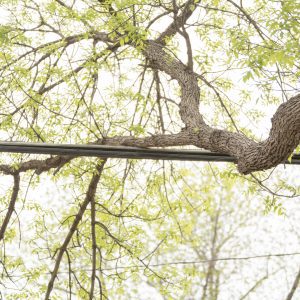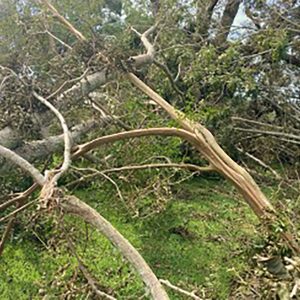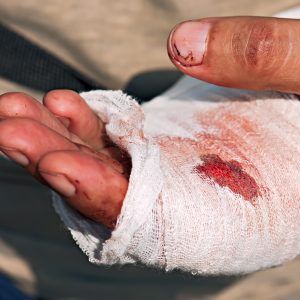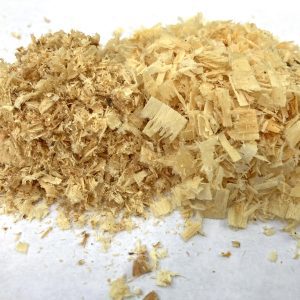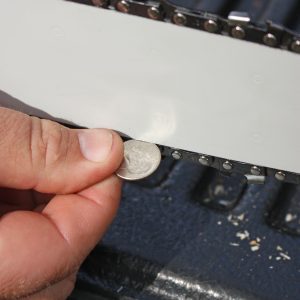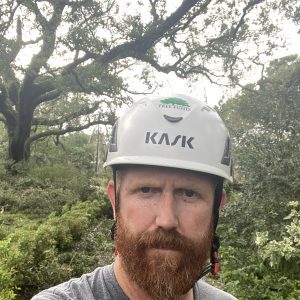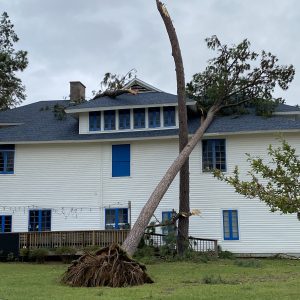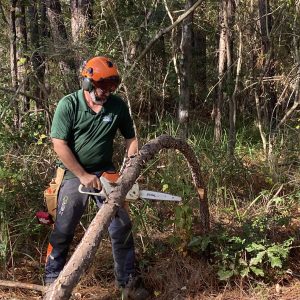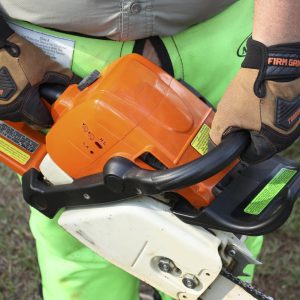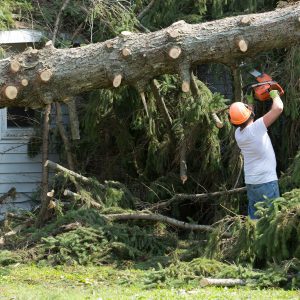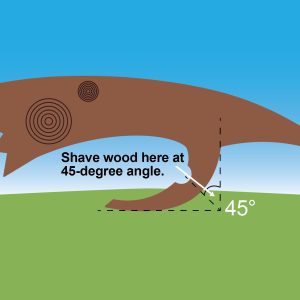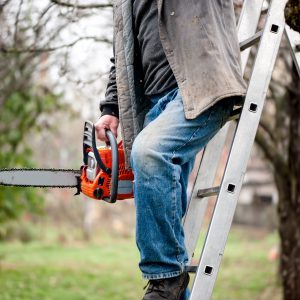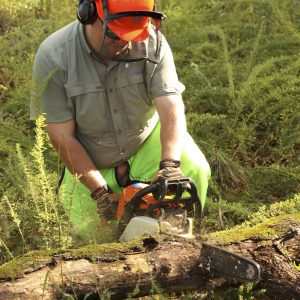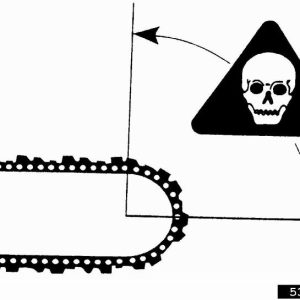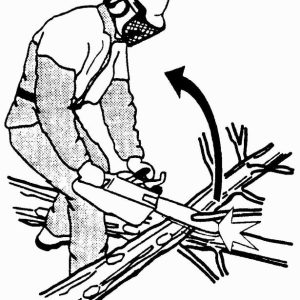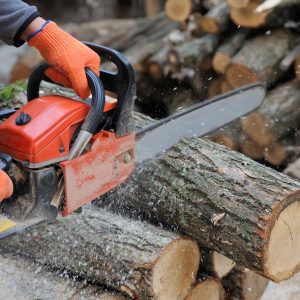Disaster

This is the third in the Restoring Storm-Ravaged Trees series. Here you will learn to recognize electrical hazards and how to apply chainsaw safety during post-storm cleanup.
More people are hurt and killed in the days and weeks after storm events than during the storms themselves. Storms generate massive numbers of fallen branches and trees, causing property damage, blocked roads, and downed utility lines.
A sense of anxiety often emerges in the hours and days after major storms. Desperation to restore landscapes or city rights-of-way to normal conditions can lead to unsafe work practices that result in injuries or loss of life. This document covers sources of danger and how to reduce injuries.
Electrical Hazard Awareness

Figure 1. Do not approach or work on trees touching power lines.
The most common reason for storm power outages is trees breaking and falling onto power and communications lines. Utility companies do their best to keep lines clear of branches to prevent outages, but in strong storms whole trees and large branches fail, causing problems.
After a storm passes and you first go outside, look carefully for damaged trees in contact with power lines. Follow these safety protocols when approaching storm- damaged trees that may be in contact with power lines or power lines that have fallen due to tree failure (figure 1):
- Treat all fallen power lines as live. Just because your power is out does not mean the line is not energized. The utility power may be off, but neighbors with generators may be feeding electricity back into the lines.
- Never attempt to remove branches or trees from utility lines.
- Do not remove branches from communications lines. Even television cables and telephone lines can hurt you. Do not touch them or anything in contact with them.
Electrical lines are usually located at the top of the power pole. The higher on the pole the line is, the more powerful that line. You also can look at the ceramic insulating discs. The utilities use bowl-shaped ceramic discs as insulators between the lines and the poles. More discs equal more power (figure 2).
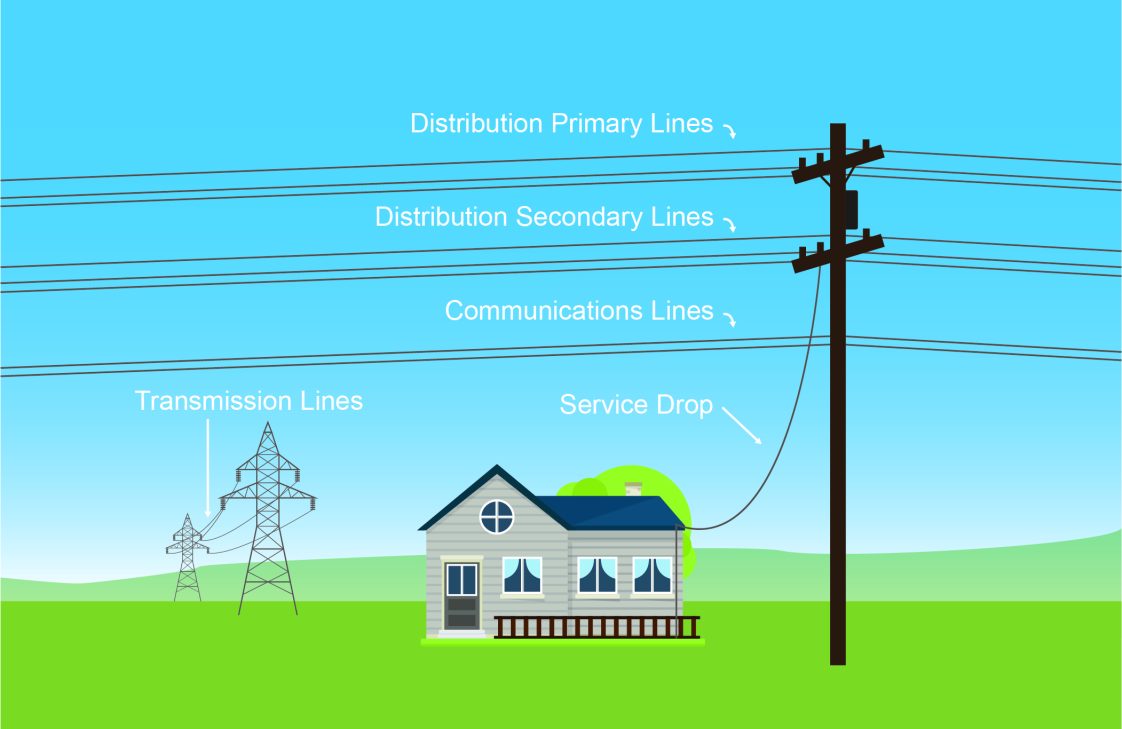
Figure 2. Stay at least 10 feet away from distribution lines. If trees are in contact with these lines, DO NOT prune or touch those trees.
Before approaching a tree that might be in direct contact with utility wires, examine it from multiple angles. Do not approach or touch the tree if you see contact with lines. The more powerful the lines the tree is in contact with, the more likely that both the tree and the ground around it are energized. The voltage in the ground gradually decreases as you move away from the tree. It is therefore recommended that you stay at least 33 feet from energized trees (figure 3).
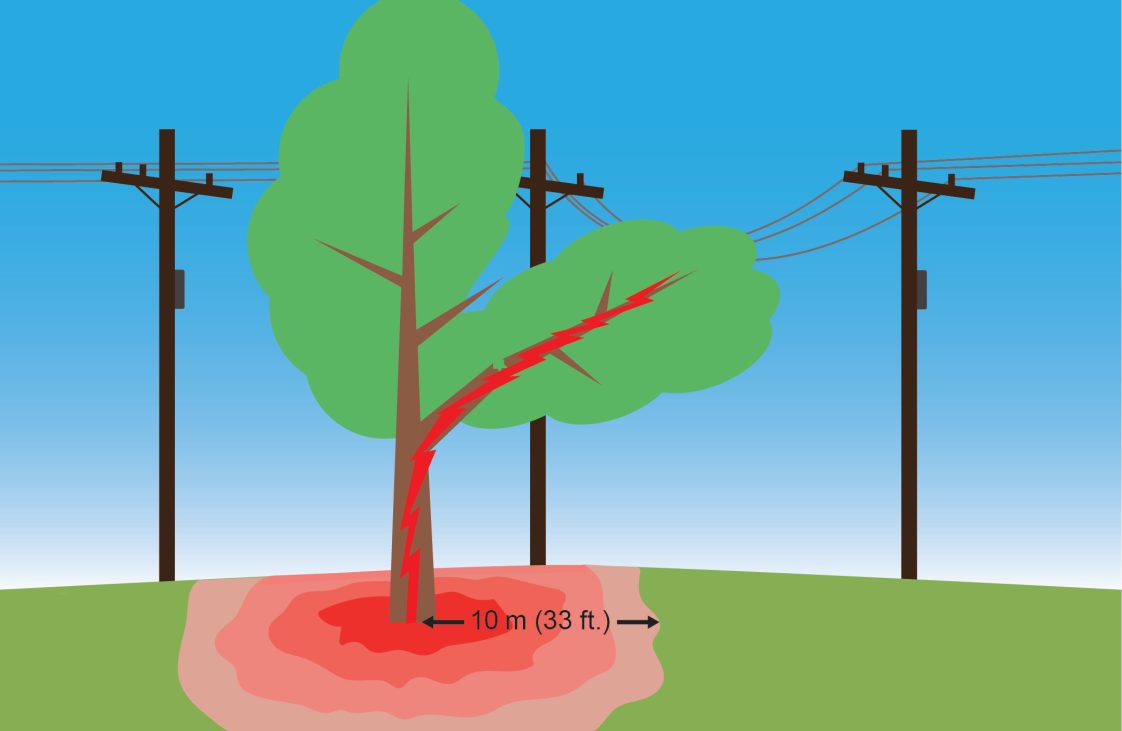
Figure 3. Do not approach trees that are in contact with distribution or high-voltage transmission lines. The tree and the ground can be energized. Stay at least 33 feet away.
If someone has been injured or rendered unconscious by contact with a utility line or a tree in contact with a utility line, do not approach that person. If the person is energized and you touch them, you also will be shocked and become a second victim. Always call the emergency authorities and allow them to approach someone harmed by electrical lines. In the case of electrical danger, you are more likely to harm yourself in the attempt than to rescue the fallen.
When working in your landscape or on municipal trees, ensure that they are at least 10 feet from power lines (figure 4). Activities such as pruning can cause branches to contact and energize the entire tree or tools. Similarly, do not work on trees where power lines are in or under the canopy. If trees are within 10 feet, contact your local utility company before pruning or removing those trees.
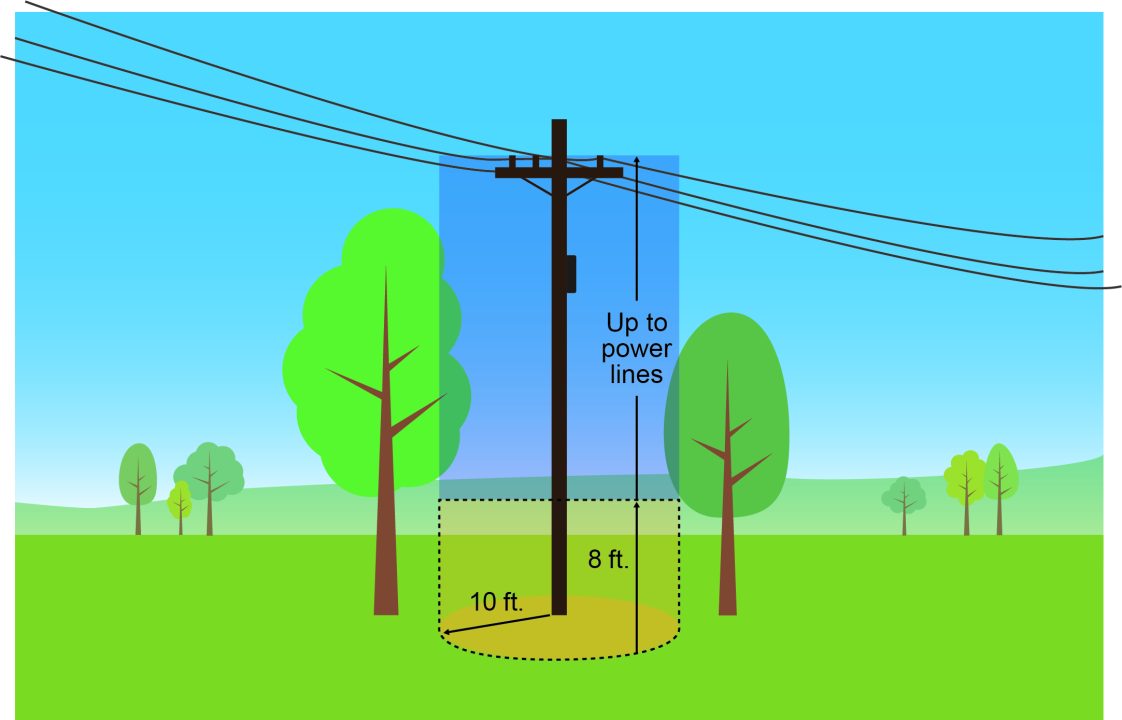
Figure 4. Do not work on trees or branches within 10 feet of power lines.
Under normal conditions it is not uncommon to find trees with branches touching power lines. Do not touch or prune anything in these trees as they could be energized. Instead, call your local utility company. In most cases they are happy to prune or remove these trees (figure 5).
- Figure 5. Do not work on trees that are touching power lines. These trees could be energized.
- Figure 6. The trees in the foreground are bent over by the fallen tree. These trees are under tremendous tension and could be dangerous to cut.
- Figure 7. Thirty-five percent of injuries occur to the left hand due to operators removing the hand to hold limbs or drag brush. Always keep two hands on the saw unless the chain brake has been engaged.
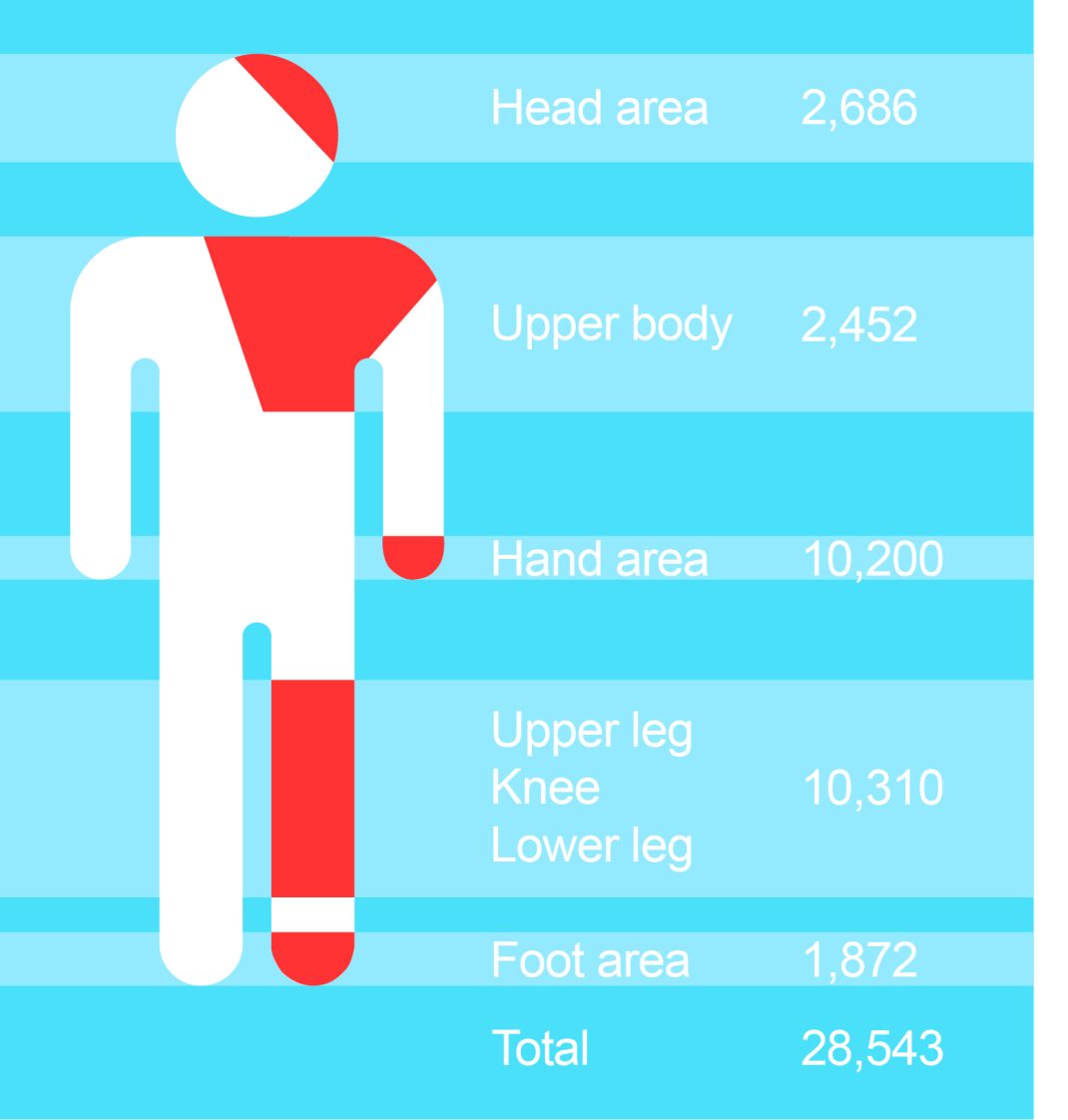
Figure 8. Wearing sturdy boots and chainsaw chaps can prevent 40 percent of injuries. Keeping two hands on a chainsaw can reduce an additional 35 percent of injuries.
Chainsaw Safety
Storms twist, bend, break, and uproot large trees, creating some of the most dangerous cutting situations. Downed trees can be under tremendous forces from bending and stretching wood fibers. This in combination with the significant weight of green wood makes for dangerous trees (figure 6). Cutting downed trees can be hazardous if the chainsaw operator is not experienced and prepared. More than 35,000 people are injured each year in chainsaw accidents.
A recent study showed that lacerations (cuts) are the primary type of injury, accounting for more than 80 percent of all chainsaw injuries in emergency rooms. Over 35 percent of the injuries occur to the left hand or fingers (figure 7), while about 40 percent are to the left leg (figure 8). The average injury requires more than 110 stitches.
Many of these injuries are preventable with use of proper personal protective equipment (PPE) and basic saw operating procedures. Ideally, every chainsaw operator should attend chainsaw safety training to learn, reinforce, and hone their skills. The following section is not a complete guide to chainsaw safety, but rather is aimed at providing key information to improve the safety of chainsaw operators responding to post-storm events.
Select the Right Chainsaw
Bigger is not always better. Larger saws are heavier and cause operators to fatigue faster, resulting in a higher risk of injury. Consider these factors when selecting a saw:

Figure 9. Battery-powered chainsaws offer a good alternative as they are quieter, require less maintenance, and have enough power for smaller projects.
- Fuel type. Today there are both battery- and gas- powered saws. While gas-powered saws are more powerful, battery-powered saws are quieter, have instant push-button startup, are low maintenance, and are powerful enough for most smaller jobs. Battery-powered saws are just as dangerous as their gas counterparts. Having two batteries is recommended as run time is approximately 30 minutes (figure 9).
- Size. High-power and long-bar saws have a greater capacity to cut larger and tougher hardwood trees; however, they are heavier and more likely to cause fatigue and injury. A lightweight saw with a guide bar between 8 and 15 inches is appropriate for cutting small limbs and trees. A midweight saw with a 16-to- 20–inch guide bar is typically sufficient for hurricane cleanup. Avoid guide bars over 20 inches since they typically are considered professional grade.
- Frequency of use. Most manufacturers make homeowner, farm, and professional-grade saws. Homeowner saws are inexpensive and designed for intermittent use. Professional-grade saws are more durable and can withstand everyday use, but they come at a premium price. For post-storm operation, homeowner or intermediate farm-grade saws are sufficient.
Ensure the Chainsaw’s Safety Features Are Working
Avoid using older saws as they may not have all the modern safety features (figure 10). Prior to starting storm cleanup, look for the following safety features that are often missing or broken on older saws:
- Chain brake. This is manually engaged by moving the front handle guard forward. The chain should not rotate when engaged.
- Chain catcher. This is a small aluminum or plastic piece under the saw where the chain enters the housing. It prevents the chain from whipping back and striking your hand should it slip off the bar.
- Throttle interlock. This system requires a palm trigger to be pressed before the throttle trigger can be engaged. It prevents brush or other objects from inadvertently engaging the throttle.
- Centrifugal clutch. This connects the engine drive shaft and the chain sprocket. When the engine is idle, the clutch disengages and causes the chain to stop spinning. Do not use the saw if the chain continues to spin at idle.
For a complete list of safety features see “Chainsaw Safety: Safety Features and Maintenance” (Extension publication FOR-2084).
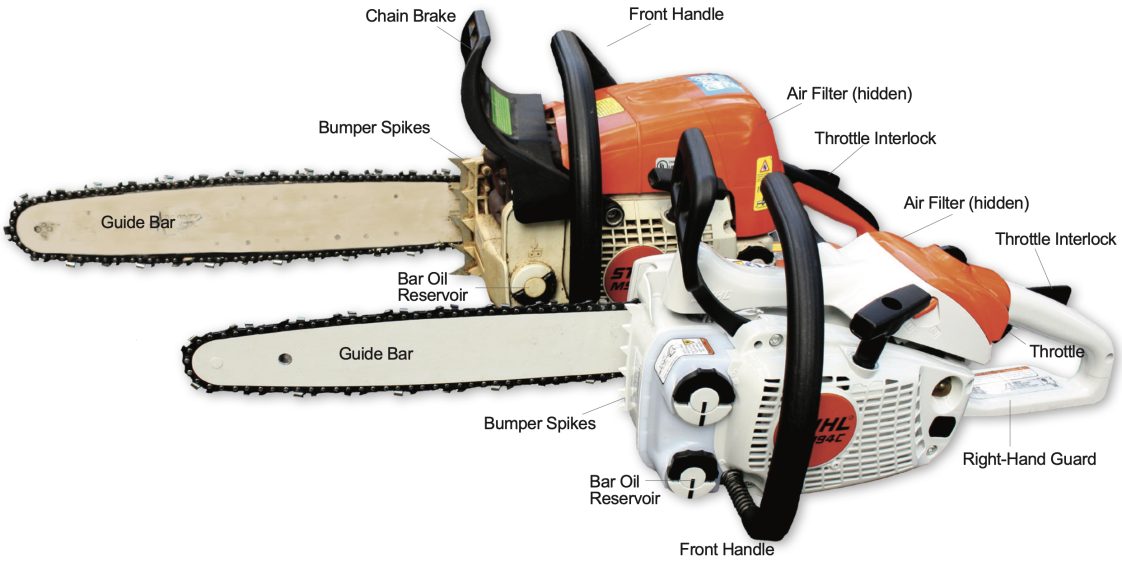
Figure 10. Before starting the saw, ensure that all safety features are in working order.
Make Sure the Saw Is In Good Working Condition
Read the chainsaw’s manual and be sure you follow the maintenance recommendations. Modern chainsaws are high-performance tools and degrade quickly if used without proper maintenance (an excellent reason to consider battery-powered saws). Following are basic maintenance guidelines:
- Keep the chain sharp. Dull chains make you work harder, and with increased fatigue comes a higher risk of injury (figure 11).
- Check chain tension. Tighten to the manufacturer’s recommendations to avoid damage to the bar or injury (figure 12).
- Check that the chain bar oil reservoir is full.
- Fuel chainsaw with the manufacturer’s recommended mix.
- Clean air filters. Over time sawdust and other debris can clog saws and reduce efficiency.
- Figure 11. Fine sawdust or increasingly smaller chips are signs of a dull chain, as seen on the left side of the photo.
- Figure 12. The chain should be tensioned to a dime’s width.
Protect Yourself
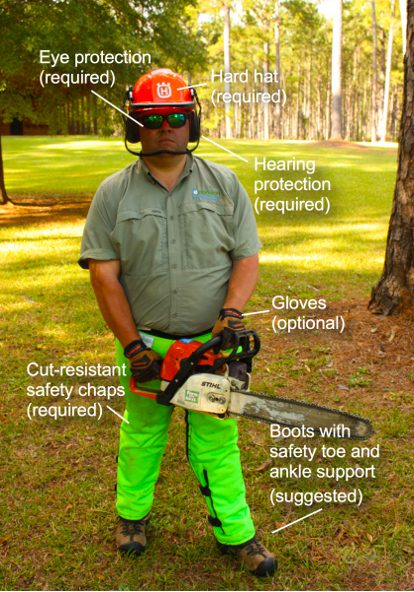
Figure 13. Regardless of whether you run a saw for 5 minutes or 5 hours, wear all your PPE.
Only operate chainsaws with the proper safety gear (figure 13). The same power that makes the chainsaw so useful is what makes it so dangerous. Always use the following protective equipment:
- Chainsaw chaps leg protection with either jamming or barrier-type material to prevent leg cuts
- Hard hat to protect the head from falling limbs and kickback
- Safety glasses to prevent injury from flying wood chips
- Earmuffs or earplugs to protect from hearing degradation
- Gloves to protect hands from abrasions and cuts
- Heavy work boots or shoes with steel toes (recommended)
For a complete discussion on PPE see www.aces.edu/blog/topics/forestry/chainsaw-safety-personal-protective-equipment.
Develop A Safety Plan
Having simple work plans in place helps you to avoid confusion, expedite emergency response, and ultimately saves lives (figure 14). Below are a few key recommendations:
- Avoid working alone. Chainsaw injuries are usually severe, and you will need backup to administer first aid, call emergency responders, and help them find you.
- Write down your worksite address and make sure others know where it is. Too often worksites have no precise address. Injuries are too frightening and confusing for people to be expected to calmly search out an address. Writing down the worksite address and making sure everyone knows where it is avoids confusion when calling emergency responders.
- Have a well-stocked first aid kit. Keep a complete kit, with dressings and blood stoppers, that is easily accessible, and be sure everyone knows where it is. Again, injuries are frightening and confusing. No one should have to desperately search for the first aid kit.
- Assign responsibilities in case of injuries. Everyone should know their job should an injury occur. These include who calls 911, who drives out to guide responders to the worksite, and who administers first aid.
- Have a vehicle ready. Jobs sites can be hard to find. Designate a vehicle and a driver, and ensure the keys are with the vehicle. Face the vehicle in the right direction and ensure it has a clear path to save time in an emergency.

Figure 14. Fill out and print simple work plans to avoid confusion, speed emergency response, and ultimately save lives. Place safety plans in a predetermined location everyone can find.
Worksite Safety Considerations
Before starting, slow down and examine the site for potential hazards. Look for the following hazards before starting:
- Power lines. Avoid cutting trees within 10 feet of a line or those that might come in contact with electrical lines when falling. If a tree is in contact with lines, always assume they are hot and call the correct electric company. Entire trees can become electrified if branches come in contact with lines. Placing the saw in these trees can result in electrocution.
- Overhead hazards. Wear hard hats since small limbs continue to fall from trees in the days and weeks after storm events. Avoid working under trees with snags or hung limbs (figure 15).
- Tripping hazards. Remove brush or other material that might tangle the operator or their saw.
- Hung trees. Avoid working on large trees leaning or hanging on other trees or structures (figure 16). These trees require heavy equipment to ensure they are removed safely.
- Spring poles. Spring poles occur when a tree or branch is bent and held in place by debris or another tree. These are hazardous cutting situations (figure 17). The bend in the branch or trunk acts like a spring, storing the force that bent it, and can lash out or snap with extreme force when cut. Injuries such as contusions or broken bones are common when a spring pole is improperly cut. Do not attempt to cut the tree if the spring pole is over your shoulders; instead, hire professionals.
- Figure 15. Days or weeks after storms, hanging limbs or poorly attached limbs can fall and strike cleanup crews. Even small limbs can cause life-threatening injuries. All workers must wear a hard hat.
- Figure 16. Large trees on structures often require large equipment to safely remove them.
- Figure 17. Approach spring poles with extreme caution. If improperly cut, they can result in serious injury.
When cutting spring poles below shoulder height, you need to use methods that may seem counterintuitive:
- Do NOT cut into the outside edge of the bowed spring pole! This wood is under extreme tension and will cause a quick, uncontrolled explosive release that may injure you. Instead, cut inside the bend of the spring pole at the tightest part of the bend. This is the compressed wood that is safer to cut.
- Cutting straight into the compression wood will cause the saw kerf to close and pinch the saw. Instead, shave it lightly along the grain with the chainsaw. You want to gradually shave away the tightly compressed wood.
- Once you have removed enough wood, the spring pole will slowly release, hinging on the outside tension wood and slowly releasing the pressure, thus keeping you safe.
Basic Saw Handling Guidelines
Chainsaws are designed with safety and ergonomic features to reduce worker fatigue and injury. Following are key guidelines to operating a saw:
- Always have two hands on the saw unless the chain brake is engaged. Thirty-five percent of injuries occur to the left hand due to removing one hand to hold a branch or drag brush while the chain is turning (figure 18).
- There are no left-handed chainsaws. Your left hand goes on the forward bar and the right on the throttle handle. Reversing hands places your body mass in the path of potential kickbacks.
- Wrap thumbs completely around handles. Operators too often wrap their fingers but lay their thumbs parallel to the handle. A good grip gives you more control.
- Engage the chain brake if you are taking two or more steps. Think of the chain brake like a gun’s safety. Disengage the brake only when actively cutting. Working in the woods around downed trees presents plenty of tripping hazards.
- Do not use the chainsaw at or above shoulder height. You have less control of the saw, and it will be more prone to kickbacks (figure 19).
- Operate the saw with both feet firmly planted on the ground, shoulder width apart, and in a boxer’s stance (one foot slightly in front of the other).
- Avoid ladders or climbing in or on trees. If your feet have to leave the ground, leave these situations to professionals with the right tools and equipment (figure 21).
- Avoid bending over at the waist when cutting. Chainsaws weigh between 10 and 14 pounds. When you hold it away from your body, it causes back strain. Instead, take a knee and cut in a position that does not stress the lower back (figure 22).
- Figure 18. Always use two hands on the saw. Wrap thumbs around handles and engage the chain brake if removing a hand or taking more than two steps.
- Figure 19. Never operate a saw over shoulder height. You have less control, are more prone to kickbacks, and will physically tire faster.
- Figure 20. Similar to spring poles, compressed limbs need the release of pressure before removal.
- Figure 21. Do not operate saws from a ladder, on roofs, or on top of trees. These are unstable platforms that can shift and move when trees are cut.
- Figure 22. Do not bend over when cutting wood on the ground; instead, take a knee. This reduces back fatigue and provides more control.
Reducing Rotational Kickback
Before starting, it is essential to understand rotational kickback. Kickback forces are generated when the upper quadrant of the bar tip contacts an object or meets resistance, causing the chain to stop (figure 23). This causes the saw bar to rotate violently in the opposite direction, resulting in cuts to the head, shoulders, or legs (figure 24). There are various ways to protect yourself from kickback, but the critical point is to avoid touching anything with the upper half of the saw’s tip.
Following are guidelines to reduce kickbacks:
- Know where the end of the saw is at all times, and avoid bringing it in contact with objects.
- Lock your left elbow and hold the saw using a firm two-handed grip.
- When cutting, operate the saw at full power.
- Stand to the left of the guide bar and do not look down at the saw kerf while cutting (figure 25).
- Use a low-kickback chain. These consumer-grade chains have built-in safety features that reduce the likelihood of rotational kickback when the chain meets resistance. Inexperienced operators should use these chains.
- Figure 23. The chainsaw’s kickback zone or no-go portion should not come in contact with trees or branches while the chain is rotating. If it does, it can create a violent upward rotation that can strike the operator in the chest or head. (Photo credit: International Society of Arboriculture, Bugwood.org)
- Figure 24. Kickbacks happen suddenly and can cause serious injury. Always beware of the chainsaw tip. (Photo credit: International Society of Arboriculture, Bugwood.org)
- Figure 25. Hold the saw slightly to one side. If you can see into your saw kerf, a kickback can strike your chest or face.
Starting the Saw
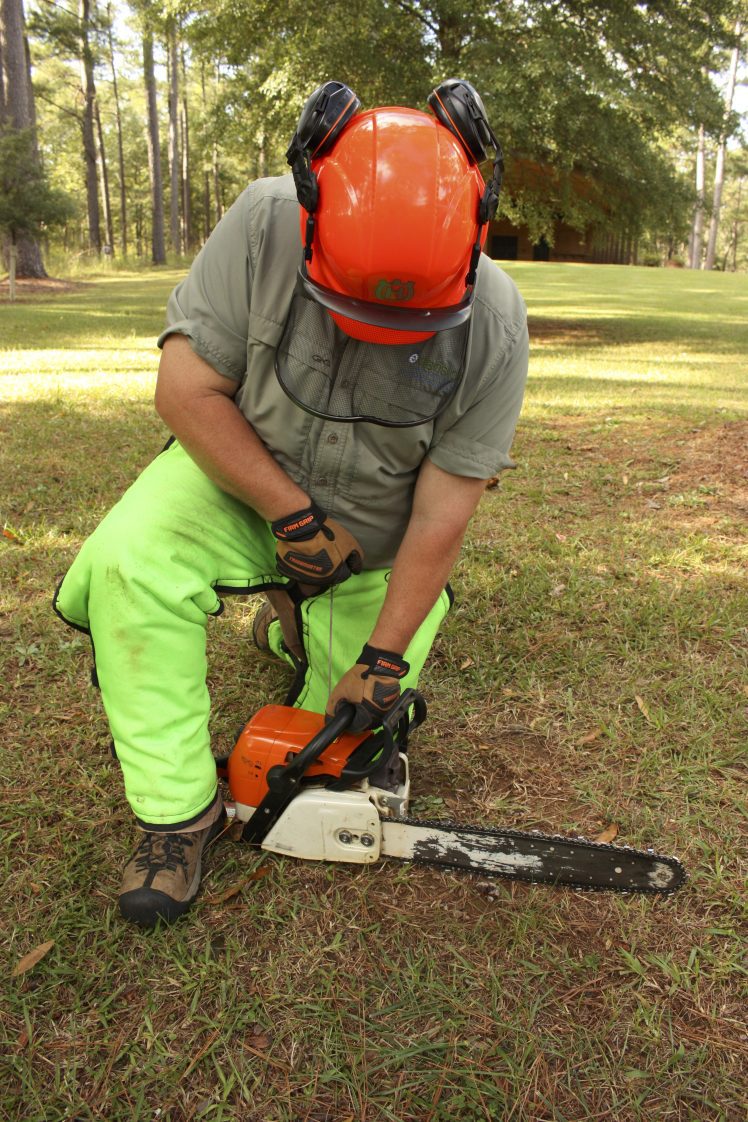
Figure 26. Pull the cord with short, quick tugs.
Do not drop-start the saw. The maneuver requires the operator to push the saw downward using one hand while pulling the cord upward with the other hand. This method is hazardous as there needs to be more control of the saw. If the saw starts, the moving chain can contact any number of things resulting in danger of kickback, damage to yourself or objects, and damage to the saw.
Place the chainsaw on a flat surface as close to the work area as possible. Engage the chain brake, place your left hand on the top handle, and hold the saw steady with your foot placed in the rear handle bracket. Finally, pull the cord with short, quick tugs (figure 26).
Limbing Trees
Following are basic recommendations (in order) for limbing fallen trees (figure 27):
- 1.Evaluate the potential for the tree to roll when you start removing branches and start from the uphill side.
- 2. Evaluate limbs, often those under the tree, that are under pressure and supporting the tree (figure 27). These limbs are very dangerous as they have massive amounts of stored energy (evident in bent or twisted limbs) that can lash out if improperly released and strike the operator or result in a tree rolling over. Leave these limbs for last.
- 3. Remove weight from the tree starting at the base. This can be done by first removing limbs on top of the trunk. Cut these limbs as far up the top side of the trunk as possible.
- 4. Make sure you flush cut limbs to avoid injury from stubs.
- 5. Start removing lateral limbs once the weight has been reduced. Leave the tensioned limbs for last.
- 6. Cut the tensioned limbs. Cutting the outside of the bent limbs or tension wood can release explosive forces and cause injury. To release tension pressure, shave the wood on the inside of the bent branch. This will weaken the compressed wood and release pressure more slowly.
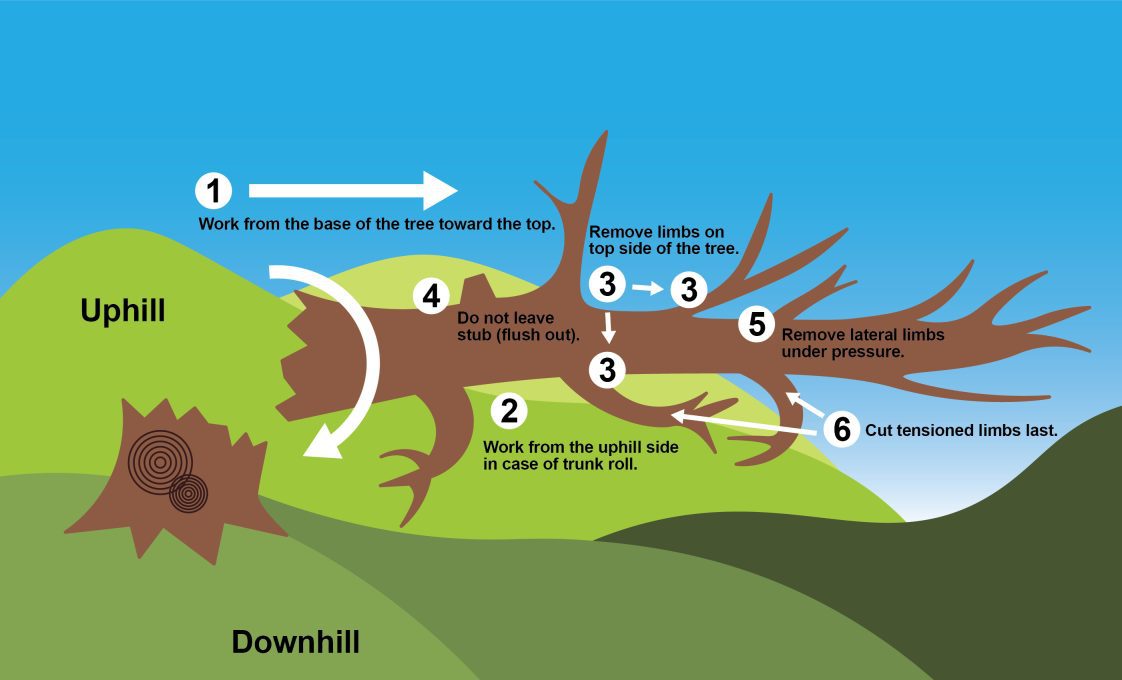
Figure 27. Limbing and bucking workflow. Always start from the butt of the tree. Work from the uphill side in case of roll. Remove limbs on top of the trunk first to prevent trunk roll. Release limbs under pressure before bucking the trunk.
 Arnold “Beau” Brodbeck, Extension Specialist, Community Forestry and Arboriculture, and Jack Rowe, Regional Extension Agent, Forestry, Wildlife, and Natural Resources, both with Auburn University
Arnold “Beau” Brodbeck, Extension Specialist, Community Forestry and Arboriculture, and Jack Rowe, Regional Extension Agent, Forestry, Wildlife, and Natural Resources, both with Auburn University
New November 2023, Restoring Storm-Ravaged Trees: Post-Storm Landscape Safety, FOR-2135

